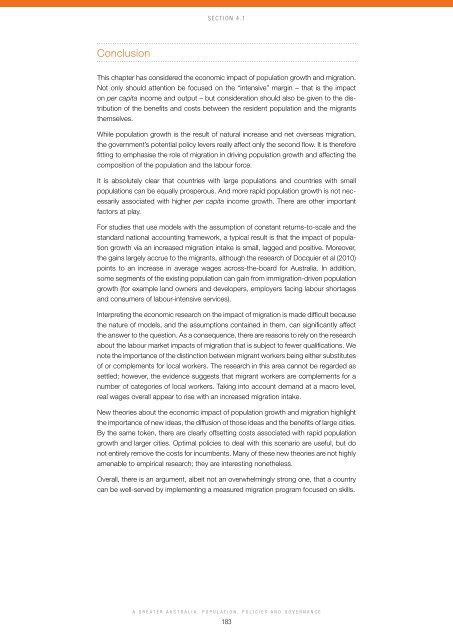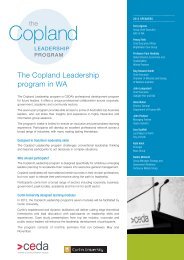Section 4.1ConclusionThis chapter has considered the economic impact of population growth <strong>and</strong> migration.Not only should attention be focused on the “intensive” margin – that is the impacton per capita income <strong>and</strong> output – but consideration should also be given to the distributionof the benefits <strong>and</strong> costs between the resident population <strong>and</strong> the migrantsthemselves.While population growth is the result of natural increase <strong>and</strong> net overseas migration,the government’s potential policy levers really affect only the second flow. It is thereforefitting to emphasise the role of migration in driving population growth <strong>and</strong> affecting thecomposition of the population <strong>and</strong> the labour force.It is absolutely clear that countries with large populations <strong>and</strong> countries with smallpopulations can be equally prosperous. And more rapid population growth is not necessarilyassociated with higher per capita income growth. There are other importantfactors at play.For studies that use models with the assumption of constant returns-to-scale <strong>and</strong> thest<strong>and</strong>ard national accounting framework, a typical result is that the impact of populationgrowth via an increased migration intake is small, lagged <strong>and</strong> positive. Moreover,the gains largely accrue to the migrants, although the research of Docquier et al (2010)points to an increase in average wages across-the-board for <strong>Australia</strong>. In addition,some segments of the existing population can gain from immigration-driven populationgrowth (for example l<strong>and</strong> owners <strong>and</strong> developers, employers facing labour shortages<strong>and</strong> consumers of labour-intensive services).Interpreting the economic research on the impact of migration is made difficult becausethe nature of models, <strong>and</strong> the assumptions contained in them, can significantly affectthe answer to the question. As a consequence, there are reasons to rely on the researchabout the labour market impacts of migration that is subject to fewer qualifications. Wenote the importance of the distinction between migrant workers being either substitutesof or complements for local workers. The research in this area cannot be regarded assettled; however, the evidence suggests that migrant workers are complements for anumber of categories of local workers. Taking into account dem<strong>and</strong> at a macro level,real wages overall appear to rise with an increased migration intake.New theories about the economic impact of population growth <strong>and</strong> migration highlightthe importance of new ideas, the diffusion of those ideas <strong>and</strong> the benefits of large cities.By the same token, there are clearly offsetting costs associated with rapid populationgrowth <strong>and</strong> larger cities. Optimal <strong>policies</strong> to deal with this scenario are useful, but donot entirely remove the costs for incumbents. Many of these new theories are not highlyamenable to empirical research; they are interesting nonetheless.Overall, there is an argument, albeit not an overwhelmingly strong one, that a countrycan be well-served by implementing a measured migration program focused on skills.A <strong>Greater</strong> <strong>Australia</strong>: <strong>Population</strong>, Policies <strong>and</strong> Governance183
Section 4.1Endnotes1. Productivity Commission 2011a, Submission to the Taskforce on the Sustainable <strong>Population</strong> Strategy for <strong>Australia</strong>, Canberra, May.2. Kirchner, S. 2011, ‘H<strong>and</strong>s, Mouths <strong>and</strong> Minds: Three Perspectives on <strong>Population</strong> Growth <strong>and</strong> Living St<strong>and</strong>ards’, Policy Monograph,<strong>Population</strong> <strong>and</strong> Growth Series 5, Centre for Independent Studies, Sydney.3. Pincus, J.J. 2011, ‘A population policy for <strong>Australia</strong>’, <strong>CEDA</strong> Economic <strong>and</strong> Policy Overview 2011, pp.40–49.4. Bloom, D., Canning, D. <strong>and</strong> Sevilla, J. 2003, The Demographic Dividend: A New Perspective on the Economic Consequences of<strong>Population</strong> Change, Santa Monica, R<strong>and</strong> Corporation.5. Productivity Commission 2011a, Submission to the Taskforce on the Sustainable <strong>Population</strong> Strategy for <strong>Australia</strong>, Canberra, May, p.9.6. Productivity Commission 2006, ‘Economic Impacts of Migration <strong>and</strong> <strong>Population</strong> Growth’, Research Report, Canberra.7. There can be significant distributional effects on the existing population, with gains accruing to the owners of l<strong>and</strong> <strong>and</strong> natural resources,at the expense of renters.8. Kirchner, S. 2011, ‘H<strong>and</strong>s, Mouths <strong>and</strong> Minds: Three Perspectives on <strong>Population</strong> Growth <strong>and</strong> Living St<strong>and</strong>ards’, Policy Monograph,<strong>Population</strong> <strong>and</strong> Growth Series 5, Centre for Independent Studies, Sydney.9. Treasury 2010, Intergenerational Report 2010, Commonwealth of <strong>Australia</strong>, Canberra.10. Productivity Commission 2011a, Submission to the Taskforce on the Sustainable <strong>Population</strong> Strategy for <strong>Australia</strong>, Canberra, May.11. McDonald, P. <strong>and</strong> Temple, J. 2008, ‘Immigration, Labour Supply <strong>and</strong> Per Capita Gross Domestic Product: <strong>Australia</strong> 2010–2050’, FinalReport, <strong>Australia</strong>n Demographic <strong>and</strong> Social Research Institute, ANU, Canberra.12. Productivity Commission 2006, ‘Economic Impacts of Migration <strong>and</strong> <strong>Population</strong> Growth’, Research Report, Canberra.13. Cobb-Clark, D. 2004, ‘Selection policy <strong>and</strong> the labour market outcomes of new immigrants’, Discussion paper no. 1380, Institute forthe Study of Labor (IZA), Bonn, Germany, November.14. Productivity Commission 2011b, Annual Report 2010–11, Canberra.15. Richardson, S. 2007, ‘What is a Skill Shortage?’ Report to National Council of Vocational Education Research, Adelaide.16. Pope, D <strong>and</strong> Withers, G., 1993. ‘Do Migrants Rob Jobs? Lessons from <strong>Australia</strong>n History 1861 – 1991’, Journal of Economic History53.4, 719-742.17. Harris, R. <strong>and</strong> Robertson, P. 2007, ‘The dynamic effects of skilled labour targeting in immigration programs’, Discussion paper No. 21,School of Economics, University of New South Wales, Sydney.18. Islam, A. <strong>and</strong> Fausten, D. 2008, ‘Skilled immigration <strong>and</strong> wages in <strong>Australia</strong>’, Economic Record, Vol. 84, S66-S82.19. Docquier, F., Ozden, C. <strong>and</strong> Peri, G. 2010, ‘The wage effects of immigration <strong>and</strong> emigration’, National Bureau of Economic Research,Working paper No. 16646, December.20. Pincus, J.J. 2011, ‘A population policy for <strong>Australia</strong>’, <strong>CEDA</strong> Economic <strong>and</strong> Policy Overview 2011, pp.40–49.21. Pincus, J.J. 2011, ‘A population policy for <strong>Australia</strong>’, <strong>CEDA</strong> Economic <strong>and</strong> Policy Overview 2011, pp.45.22. Bond, M. <strong>and</strong> Gaston, N. 2011, ‘The Impact of Immigration on <strong>Australia</strong>n-born Workers: An Assessment Using the National LabourMarket Approach’, Economic Papers, 30.3, 400–413.23. Kirchner, S. 2011, ‘H<strong>and</strong>s, Mouths <strong>and</strong> Minds: Three Perspectives on <strong>Population</strong> Growth <strong>and</strong> Living St<strong>and</strong>ards’, Policy Monograph,<strong>Population</strong> <strong>and</strong> Growth Series 5, Centre for Independent Studies, Sydney.24. Simon, J, L 1998, ‘The Ultimate Resource 2’, p 367.25. Ridley, M., 2010, The Rational Optimist: How Prosperity Evolves, Harper-Collins.26. Wilkie, J., <strong>and</strong> T McDonald, 2008, “Economic geography <strong>and</strong> economic performance in <strong>Australia</strong>”, Economic Round-up Issue No. 3, TheTreasury, <strong>Australia</strong>n Government27. Keller, W. 2002, ‘Geographic Localization of International Technological Diffusion’, American Economic Review 92:1, 120–142.28. Glaeser, E. 1998, ‘Are Cities Dying’, Journal of Economic Perspectives, Vol 12 (2), 139– 60.29. Glaeser, E. 2011, Triumph of The City, The Penguin Press, New York.30. Ciccone, A. <strong>and</strong> Hall, R. 1996, ‘Productivity <strong>and</strong> the density of economic activity’, American Economic Review, 86(1), 54–70.31. Pincus, J.J. 2011, ‘A population policy for <strong>Australia</strong>’, <strong>CEDA</strong> Economic <strong>and</strong> Policy Overview 2011, pp.40–49.32. Docquier, F., Ozden, C. <strong>and</strong> Peri, G. 2010, ‘The wage effects of immigration <strong>and</strong> emigration’, National Bureau of Economic Research,Working paper No. 16646, December.A <strong>Greater</strong> <strong>Australia</strong>: <strong>Population</strong>, Policies <strong>and</strong> Governance184
- Page 2 and 3:
A Greater Australia:Population, pol
- Page 4 and 5:
ContentsForeword CEDA Chief Executi
- Page 6 and 7:
ForewordIt is with pleasure that I
- Page 8 and 9:
IntroductionResponding to the resul
- Page 10 and 11:
IntroductionA more dynamic and vita
- Page 12 and 13:
IntroductionSustainabilityConcern a
- Page 14 and 15:
IntroductionThe new demographics, h
- Page 16 and 17:
Section 1.0Historical perspectives1
- Page 18 and 19:
Section 1.1IntroductionJapan’s cr
- Page 20 and 21:
Section 1.1Figure 1Forecast number
- Page 22 and 23:
Section 1.1Table 1Defence spending
- Page 24 and 25:
Section 1.1How much defence is enou
- Page 26 and 27:
Section 1.1ConclusionA substantial
- Page 28 and 29:
Section 1.2There has been over a ce
- Page 30 and 31:
Section 1.2Resource constraints wer
- Page 32 and 33:
Section 1.2Similarly, in the 1994 H
- Page 34 and 35:
Section 1.2ReferencesAustralia, Dep
- Page 36 and 37:
Section 1.3IntroductionAustralia is
- Page 38 and 39:
Section 1.3The grey 90sThe heady ex
- Page 40 and 41:
Section 1.3Taylor’s stony rebutta
- Page 42 and 43:
Section 1.3Figure 1The Benhamite Op
- Page 44 and 45:
Section 1.3In mathematical terms, t
- Page 46 and 47:
Section 1.3characterisation of the
- Page 48 and 49:
Section 1.3ConclusionA retrospectiv
- Page 50 and 51:
Section 2.0Population futures2.1 Fo
- Page 52 and 53:
Section 2.1Conventional population
- Page 54 and 55:
Section 2.1It is more useful for go
- Page 56 and 57:
Section 2.1Forecasting of births, w
- Page 58 and 59:
Section 2.1Future net overseas migr
- Page 60 and 61:
Section 2.13). This had a lot to do
- Page 62 and 63:
Section 2.2IntroductionIn late Sept
- Page 64 and 65:
Section 2.2Figure 1The migrant cont
- Page 66 and 67:
Section 2.2The visa and residency s
- Page 68 and 69:
Section 2.2sponsorship, subject to
- Page 70 and 71:
Section 2.2Figure 3Historical and p
- Page 72 and 73:
Section 2.2The views in this chapte
- Page 74 and 75:
Section 2.3IntroductionThe Australi
- Page 76 and 77:
Section 2.3Figure 3Australia: Distr
- Page 78 and 79:
Section 2.3Table 2Australia: Popula
- Page 80 and 81:
Section 2.3Table 4Views of Australi
- Page 82 and 83:
Section 2.3Table 5Australian States
- Page 84 and 85:
Section 2.3A number of hypotheses h
- Page 86 and 87:
Section 2.3Table 8Australia: Distri
- Page 88 and 89:
Section 2.3Table 10Non-Metropolitan
- Page 90 and 91:
Section 2.3Policy issuesThe configu
- Page 92 and 93:
Section 2.3Climate change is likely
- Page 94 and 95:
Section 2.3ConclusionAny realistic
- Page 96 and 97:
Section 2.340 Swan, W., 2010.Austra
- Page 98 and 99:
Section 2.4IntroductionThe Australi
- Page 100 and 101:
Section 2.4At present there is a hi
- Page 102 and 103:
Section 2.4innovation initiatives w
- Page 104 and 105:
Section 2.4Endnotes1 Henry, K 2009,
- Page 106 and 107:
Section 2.5IntroductionAustralia is
- Page 108 and 109:
Section 2.5else. Even with a broad
- Page 110 and 111:
Section 2.5commercially viable - th
- Page 112 and 113:
Section 2.5A vast country like Aust
- Page 114 and 115:
Section 3.0Society and the individu
- Page 116 and 117:
Section 3.1Extent of public opinion
- Page 119 and 120:
Section 3.1category immigrant/forei
- Page 121 and 122:
Section 3.1The Environics Research
- Page 123 and 124:
Section 3.1Per cent100908070Figure
- Page 125 and 126:
Section 3.1A number of surveys soug
- Page 127 and 128:
Section 3.1Table 8Percentage who an
- Page 129 and 130:
Section 3.1A more precise indicatio
- Page 131 and 132:
Section 3.1The strongest predictor
- Page 133 and 134: Section 3.1Endnotes1. There is also
- Page 135 and 136: 3.2Social inclusion and multicultur
- Page 137 and 138: Section 3.2a broader definition of
- Page 139 and 140: Section 3.2Figure 1Estimated povert
- Page 141 and 142: Section 3.2Table 2Visa Type of Sett
- Page 143 and 144: Section 3.2Table 5First Generation
- Page 145 and 146: Section 3.2Table 6Australia: First
- Page 147 and 148: Section 3.2Improving outcomes for v
- Page 149 and 150: Section 3.2increasing diversity of
- Page 151 and 152: 3.3Linkages between education and p
- Page 153 and 154: Section 3.3Education and productivi
- Page 155 and 156: Section 3.3In the past decade, prod
- Page 157 and 158: Section 3.3succeed in education or
- Page 159 and 160: Section 3.3case, funding also could
- Page 161 and 162: Section 3.3Endnotes1 IGR 2010: Chal
- Page 163 and 164: 3.4Healthcare delivery for our agei
- Page 165 and 166: Section 3.4• Private medical serv
- Page 167 and 168: Section 3.4the whole spectrum of in
- Page 169 and 170: Section 3.45. Experiences, pathways
- Page 171 and 172: Section 3.4Stratification of patien
- Page 173 and 174: Section 3.4Other steps include impr
- Page 175 and 176: Section 3.438 National Health Refor
- Page 177 and 178: 4.1The economic effects ofpopulatio
- Page 179 and 180: Section 4.1population growth can ex
- Page 181 and 182: Section 4.1In theory, the answer pa
- Page 183: Section 4.1Kirchner concedes that t
- Page 187 and 188: 4.2Urban infrastructure and land us
- Page 189 and 190: Section 4.2bearing the fixed costs
- Page 191 and 192: Section 4.2Figure 1Indicative dwell
- Page 193 and 194: Section 4.2Taking the electricity,
- Page 195 and 196: Section 4.2Promoting better land us
- Page 197 and 198: Section 4.2preferences to homeowner
- Page 199 and 200: Section 4.2in any Australian urban
- Page 201 and 202: Section 4.2Endnotes1 Productivity C
- Page 203 and 204: 4.3Water security:Water for the far
- Page 205 and 206: Section 4.3Water trading enables us
- Page 207 and 208: Section 4.3cent of water entitlemen
- Page 209 and 210: Section 4.3were either the full eco
- Page 211 and 212: Section 4.3Strategic opportunitiesA
- Page 213 and 214: 4.4Critiquing governmentregional de
- Page 215 and 216: Section 4.4However, there is often
- Page 217 and 218: Section 4.4Potential policy interve
- Page 219 and 220: Section 4.4Unfortunately, advocacy
- Page 221 and 222: Section 4.4contribute substantially
- Page 223 and 224: Section 4.418 Department of Educati
- Page 225 and 226: 5.1The future of population policyG
- Page 227 and 228: Section 5.1a million fewer women in
- Page 229 and 230: Section 5.1For the present, ongoing
- Page 231 and 232: Section 5.1The second worry is that
- Page 233 and 234: Section 5.1The now significantly de





